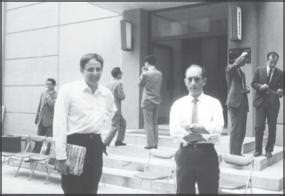by David Mumford
David Mumford describes Bott’s “job talk” at Harvard and the transformation in the culture of the Harvard mathematics department upon Bott’s arrival in 1959.1

My first encounter with Raoul was most memorable. I was still a lowly undergraduate at Harvard, though taking some advanced courses. One day in 1958, Raoul came to give the colloquium talk, a weekly affair Thursdays at 4:30 in 2 Divinity Avenue (rotating with MIT but not, if I recall correctly, with Brandeis as yet). The stage at 2 Divinity was on a low platform, maybe three feet high with low stairs on each side. After being introduced, Raoul did what no one else had ever done: he marched directly onto the stage with a small jump. His enthusiasm was both physical and mental. He proceeded to mesmerize the assembled crew of senior professors, first explaining Morse theory, a brand new tool for the conservative audience, and then his periodicity theorem. Of course I didn’t know it, but it was a job talk — he was coming to Harvard!

To put this in context, it’s important to know what sort of a place Harvard was at the time. Dave Widder and Joe Walsh were the most senior and, together with Garrett Birkhoff, represented the tradition from the 1930s. At a dinner party with the Walshes, although a tuxedo was no longer expected, the women still left the dining room after dessert so the men could light their cigars and discuss masculine topics. Lars Ahlfors, Richard Brauer, and Oscar Zariski were the European stars who had put the department on the map. The younger generation was represented by the three American functional analysts: Andy Gleason, George Mackey, and Lynn Loomis. But it was still a very conservative place run by conservative gentlemen. Faculty wives put on white gloves to serve tea before the colloquium. Saunders Mac Lane had left for Chicago, so his fancy ideas in topology, cohomology, sheaves, and so on were unknown areas at Harvard. Semi-simple Lie groups were a distant concept.

Enter Raoul. He was not a breath of fresh air; he was a gale — not merely the new and wonderful mathematical topics that he brought in his tool kit, but his spark, his energy, his fearlessness. You know how universal it is to refrain from asking what you fear may be a stupid question when a seminar speaker begins to lose you? Not Raoul! He regularly raised his hand and asked that “stupid question”, half knowing the answer but wanting to slow down the speaker, hear it again, and bring the rest of us into the circle of mutual appreciation present in the best seminars. Being ashamed not to know something basic was completely alien to his temperament.

And then there were the “colloquium parties”. I think these became a regular fixture in the 1960s: every Thursday the speaker’s host invited a large part of the Boston research community and their spouses to a party. Here were these clusters, typically the guys talking math and their wives talking about their families (there were no women on the faculty then). Raoul often came a bit late and would raise his voice and say something like, “What’s going on here? Is this a party?” or ironically, “Is this Harvard?” He wanted music and often got Tom Lehrer to play and even sing by the end of the evening.
Raoul taught me many things about both mathematics and life. I know no one who didn’t feel a lift, a rush when he came into the room. He was not merely large in stature but, more than that, large in spirit. We miss him immensely.